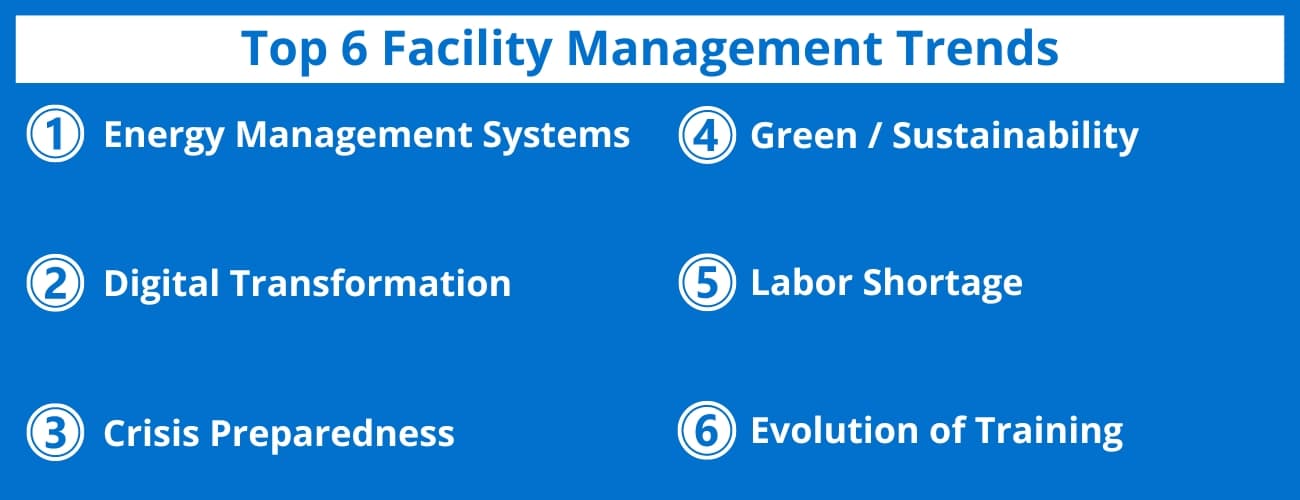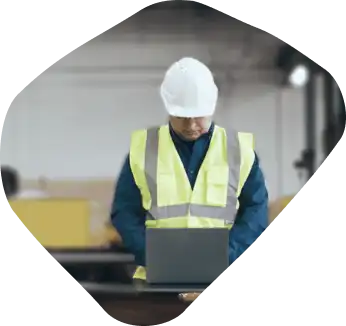February 23, 2024 8 min read

6 Facility Management Trends to Watch in 2024
Industry:
Solution:

Staying ahead of the curve is essential for business success. The facility maintenance and management industry is experiencing several transformative trends. From the integration of cutting-edge technologies to a heightened focus on sustainability, many of these trends promise advances in innovation and efficiency. Let’s explore the six facility management trends poised to shape the industry in 2024, providing a roadmap for organizations seeking not just to adapt but to thrive this year.
2024 Facility Management Trends
Facility management is a vital function across a variety of industries. From healthcare to data centers, industrial manufacturing, and real estate, numerous industries have unique maintenance and building management needs.
Regardless of your industry, there are several key trends that are shaping the facility management profession.

1. The Rise of Energy Management Systems
An energy management system (EMS) is a group of digital tools that allow facilities maintenance technicians to monitor, control, and optimize the performance of an energy system. For example, building maintenance teams need to monitor and manage the electricity use in a building.
The increasing importance of energy management coincides with the focus on sustainability in facility management—more on this shortly.
But two of the biggest trends shaping energy management in facilities are: the rise of electric vehicles (EVs) and the growth of data centers in the U.S.
The Impact of Electric Vehicles on Energy Management
Analytics predict that the EV market is set to have an annual growth rate of 9.82%—that would put the projected market value at $906 billion by 2028.
And with that growth in vehicle sales comes a facilities dilemma: the charging stations.
To keep up with demand, it’s estimated that there will need to be 3.32 million EV charging stations by 2028. And adding these stations to parking garages will completely change the layouts and electricity needs of parking structures.
In the past, parking structures needed very little electricity. But that’s changing. Now, facilities management teams must double the capacity of the electrical systems of their buildings. The solution? Energy management systems.

The Rapid Growth of Data Centers
Another unique energy management need is data centers. This industry is growing rapidly in the U.S. (which claims 40% of the global data center market). By 2030, it’s predicted that data center energy consumption will double compared to demand in 2022.
While data centers are an important part of our economy, they also come with some challenges. These buildings require a ton of energy and put off immense heat. It’s up to facility managers to manage the energy use and keep these buildings and the critical technology and equipment inside of them cool.

2. Rapid Digital Transformation
The good news is that there are numerous advancements in facility management technology. The bad news is that things are changing so quickly that it can be difficult for teams to keep up. Let’s review a few of the top facility management technology trends right now.
Smart Buildings
Smart Buildings are the future. These buildings have all their systems (including lights, alerts, security, and more) all managed on a single network. The goal of these buildings is to reduce waste and improve operational efficiency.
And there are numerous technologies that facilities teams can use to collect data and understand where and when maintenance is needed.
- Facility Management Software Systems (FMSS): Platforms that consolidate facility tasks, eliminating inefficiencies and redundancies.
- Fault Detection and Diagnostics (FDD): Solutions that detect, isolate, identify, and evaluate problems as they occur. The goal of these tools is to end the break-fix cycle of maintenance and help teams be more proactive.
- Building Automation Systems (BAS): Solutions that allow technicians and operators to access, control, and monitor multiple building systems from a single interface.
- Internet of Things (IoT): IoT builds a central environment for tracking all aspects of facility management. This technology has groundbreaking implications for the industry, and even helps with decreasing energy-related expenditures to help reach sustainability goals.
- Artificial Intelligence (AI) and Predictive Analytics: Machine learning models offer enhanced precision for improving predictive maintenance and resource allocation, helping teams be more proactive. McKinsey predicts that AI can reduce maintenance costs by 10-20%.

3. The Importance of Crisis Preparedness
Facilities teams now need to prepare for more crisis scenarios. From extreme weather conditions as a result of climate change to increases in cyberattacks, there are many ways that buildings must prepare for disaster.
In recent years, we have seen more events like extreme heat waves, superstorms, and deep freezes in southern states. And we have seen the rise of cybercrime across all industries. In response, many are pushing for investments in technologies like redundant power systems, lists of critical equipment, and systems to quickly detect and diagnose issues.
Further, employees must also be trained to respond to any crisis, which requires more extensive cross-training and succession planning to mitigate risk.
4. Everything’s Going Green
As you’ve seen across other top facility management trends, sustainability is a major theme. Everything from the technology we use to the problems companies need to solve comes back to making buildings and facilities more sustainable.
The problem—and major focus for this year—is that budgets and headcount often aren’t increasing to help FM teams achieve their aggressive sustainability goals. The challenge will be to find efficiencies and cost savings this year to ensure these goals are met without burning out maintenance staff.

5. The Ongoing Labor Shortage
Speaking of avoiding employee burnout, one of the biggest challenges in this industry is the ongoing—and worsening—labor shortage.
A staggering 51% of FM workers report wanting to quit their jobs. There are numerous causes for this turnover rate: diversity issues, low pay, lack of development opportunities, and waning interest in the profession among younger generations.
And as a result, the industry is struggling with widening skills gaps. As seasoned employees retire, a wealth of knowledge can be lost. And as young employees do join the field, they often lack a lot of basic knowledge. In an industry that needs employees who are multi-skilled, the talent pool leaves a lot to be desired.
PRO TIP: You can start closing these skills gaps with training plans for your facilities workforce.
6. The State of Workforce Training
Based on internal research, we’ve found a lot of information about how facilities management companies want to train their workforce. And it all comes back to a few basic needs:
- Big skills gaps among younger workers joining the workforce.
- Safety risks on the job mean training must be effective.
- Cross-training is required to ensure continuity of operations when employees quit.
- Technological competencies are increasing in importance to keep up with technological advancements.
But here’s the current situation of a lot of facilities teams:
- 31% are only training in person currently, which prevents them from scaling training and covering all topic areas thoroughly.
- 24% can’t track their training at all today and another 21% rely on manual tracking.
Because of these gaps and challenges with training a facilities workforce, many companies are turning to blended learning solutions where their in-person training is more interactive, and their online training is more engaging and can build a foundation of knowledge.
“One calibration technician, who has a very specialized role, was accessing HVAC courses that were not related to his job. However, it helped him identify his interest in a different career path. Therefore, we allowed him to pursue it by taking many advanced HVAC courses. He has recently obtained his EPA certification.”
— Joe Montelongo
C&W Services Facilities Manager
How You Can Stay Ahead of Facility Management Trends
A common theme across all these trends in facility management is the people. How the workforce is trained and supported will make all the difference in meeting goals, staying within budget, and tackling the major challenges in the industry.
The best way to start is to look at your own training strategy. What topics do you cover? Where are the gaps? How can you make your employees safer and better at their jobs? And, ultimately, how can you use training programs to invest in your people so they want to stay with your company?
Industrial Facility Management and Maintenance Training Library
Vector Solutions’ online industrial facilities training can help your workforce reduce risks, close skill gaps, reduce operations and maintenance costs, all while increasing safety and productivity.
View Library
If you need an eLearning provider, request a demo today to learn how we can help your company achieve your goals.








